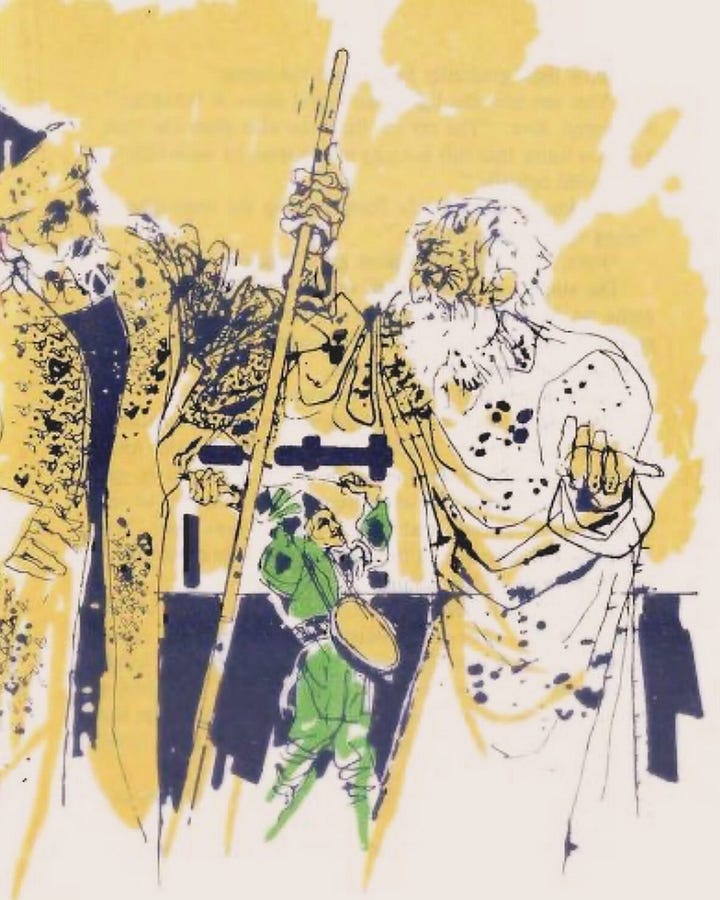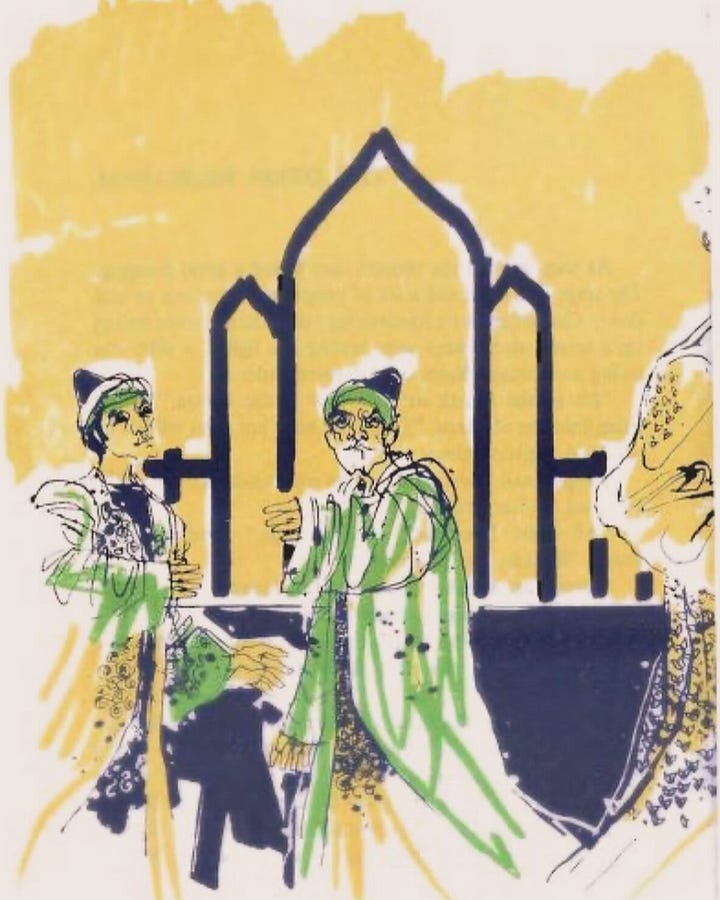Tell It Again #6: Kids
Welcome to ‘Tell It Again’, a newsletter that dives into the life and work of Girish Karnad. Our title is from an opening line in Nagamandala:
“You can't just listen to the story and leave it at that. You must tell it again to someone else.”
We want to tell his story again, through glimpses into his work, his papers, his circle of friends and collaborators, and their great creative milieu.
This week, we share some glimpses of Karnad’s work with and for young people. Appropriately, we’re breaking convention to go back to a beloved format of a decade ago: a listicle!
Woh Ghar
Woh Ghar was a 1986 film based on Kirtinath Kurtakoti’s novel in Kannada, Aa Mane (The House). The film is about a band of village children who play at being grown ups, recreating what they see adults talk about and do.
The film was to be made in Hindi, but set in rural Karnataka. When Karnad was brought on to direct the film, he insisted on casting children with Kannada backgrounds who were also fluent in Hindi. Where would you look for kids like that? The production team knocked on the doors of the Delhi Kannada School, where Sudhir Prabhu (our source for these photographs — read more on his website) was a student in eighth standard. Karnad auditioned 45 students, and cast fifteen of them in lead roles.
They shot for the film in a “crumbling old haveli in Mehrauli”, Prabhu writes, close to the Qutub Minar. The young actors, sporting “distasteful haircuts” so they looked the part of street urchins, worked on the film for all of three weeks. (Catching up with school afterward, according to Prabhu, was a bit of a challenge.)
On working with Karnad, Prabhu recalled:
“It was tough reaching up to the expectations of Girish Karnad. I once even had a severe scolding from him on the way. I had the habit of standing on ‘one and a half feet’. Even today, I sometimes remember him whenever I stand like that!”
The telefilm aired on Doordarshan in 1986, and was eventually released on cassette.
Turning Point
A generation of millennials in India first encountered Karnad as the host of Turning Point, which first aired in 1991. The show was a big moment for television and for science communication in India, particularly thanks to Professor Yash Pal, a frequent guest on the show. He took serious scientific questions — What is a biomuseum? Why are invasive species a problem? How does LIDAR work? — and brought young people into the conversation.
Here’s a cool documentary about Yash Pal, including his instrumental role on Turning Point.
Indradhanush
Imagine this: you and your friends make yourselves a computer in 1989. Then it starts talking back to you. A little weird, but you can run with that. Then it flings you back through time.
You meet your own grandfather in the past. You make friends with an alien prince trying to escape his enemies. And there’s more!
Anand Mahendroo’s Indradhanush (1989) had it all: futuristic computers, time travel, aliens, robots, friendship, and family drama. It lasted only thirteen episodes but starred a number of now-familiar names as child actors: Karan Johar, Urmila Matondkar, Vishal Singh, Ashutosh Gowariker, and of course, Karnad as the father of the protagonist, Appu.
You can watch the series of 13 episodes here!
Karadi Tales
A later generation encountered Karnad as the voice of Karadi the Bear, the narrator of folk and mythological stories on the audio-series Karadi Tales — stories such as Ganesha’s meeting with Kubera and Krishna’s childhood shenanigans. The company also produced the audio-book of Wings of Fire, the autobiography of former president Abdul Kalam, voiced by Karnad.
In 2018, about a decade after the original recordings, Shobha Viswanath, the Creative Director of Karadi Tales wrote to ask him to record a new bunch of stories.
At first he turned her down, saying his poor health had weakened his voice. But a few months later, Shobha said, “to my astonishment and joy, he contacted me expressing interest in recording the stories if we would still have him.”
He wrote to her:
“I have two grandsons — aged 4 and 6 — and my status as grandfather has shot up since they accidentally discovered I was Karadi. That in turn has enthused me to get back into Karadi storytelling.”
Karnad passed away before they could find a date to record. Viswanath told us that “[t]he four stories that we had reserved for him are still with us, bereft of the audio.”
Listen to a brief clipping of Karnad narrating the birth of Krishna here. If you’re looking for more Karadi stories, Amazon Prime has an animated series starring Karnad (and others!) as Karadi.
Cheluvi
“One day the king’s son saw the flowers. They smelled wonderful. He had never seen such flowers anywhere. ‘What flowers are these? Where do they grow, on what kind of tree? Who brings them to the palace?’ — A Flowering Tree, AK Ramanujan
‘A Flowering Tree’ is the story of two sisters with a magical secret. They are poor, and to get by, one of the sisters performs a mysterious ritual to turn herself into a flowering tree. The other sister, with great care, plucks fragrant flowers from the tree and sells them in the village. All’s well until her secret starts getting out and attracting attention — some desired, some quite unwelcome.
Karnad loved this story, and in 1992, began casting for its film adaptation, Cheluvi (1992). His old friend Satyadev Dubey had just held an acting workshop with a 17-year-old named Sonali Kulkarni. He introduced her to Karnad. Kulkarni had to do a photo shoot, then a video shoot, but she was cast as the lead. Cheluvi would be her debut film.
Her family was nervous, Sonali told us. “They were so scared that apni ladki filmon mei jaa rahi hai.” Until they visited the Karnad home: “I remember how kind and warm Saras aunty was… We were so overwhelmed to see the house, books, the light in the house, the food.”
“If it wasn’t for Girish uncle, I would have been a person who knew nothing about the film industry or theatre. I had hardly any clue,” she said. Her success has since spanned starring roles in Hindi, Marathi, and many other languages (including Arjun Sajnani’s adaptation of Karnad’s The Fire and the Rain, Agni Varsha).
“I have always written a letter and drawn a greeting card for Girish uncle since I worked under his direction,” she told us. “And he would always reply.”
Malgudi Days
Honestly, we don’t know what to say about Malgudi Days (1986); it was core memory material for more than just one generation. It was a work of titans: RK Narayan’s world, directed by Shankar Nag, and a dazzling cast of established and up-and-coming actors. Like Woh Ghar, Malgudi Days was a Hindi series with a Kannada speaking crew, starring predominantly Kannada speaking actors.
It’s legacy lives on today in unexpected ways: pitaji, aap achche pitaji hain.
Post script:




Let’s Do A Play, a book for children by Uma Anand and illustrated by Mickey Patel, had a special appearance by Karnad’s Tughlaq and a band of kids learning in a very hands-on fashion about theatre.
In other news!
The Film Heritage Foundation’s 4K restoration of Shyam Benegal’s Manthan (1976) returned to theatres in India this past weekend, on 1st and 2nd June, on World Milk Day no less!
It’s also being screened at the Avalon Theatre in Washington DC next Saturday, the 8th of June. More information here:
Karnad’s Hayavadana directed by Neelam Mansingh Chowdhry was on stage at Range Shankara this past weekend; here’s a glimpse of the production.
This newsletter and the Instagram and Facebook pages it is tied to are part of an open archive of Girish Karnad’s life and work conceived by Raghu and Chaitanya as a way to keep his wide legacy alive and in public view. Its curator is Harismita.












